
"Cambyses at the Siege of Pelusium" ,1863. Paul Marie Lenoir (1850-1881)
Egypt, Pelusium, Cambyses, cats, and heathen superstition unreasonable as profound, are leading characteristics of this scene. Men of letters who have explored the labyrinths of ancient mythology and history are generally agreed that the lowest intellectual races indulge most in animal worship, having their sacred bird, beast, fish, or even plant or inanimate object. Although it can never be maintained that the ancient Egyptians were non compos mentis, it is nevertheless a fact that animal worship occupied much of their religious thought.
Of this veneration for animals Cambyses, king of Persia (525 B. C), took advantage. Pelusium was the key to Egypt. It was strongly fortified and garrisoned, and to all appearances must delay him long. He had recourse to the "cat stratagem," thus described by Polyenus: "Being informed that the whole garrison consisted of Egyptians, he placed in the front of his army a great number of cats, dogs, sheep, and other animals, which were looked upon as sacred by that nation; and then attacked the city by storm. The soldiers of the garrison not daring to shoot an arrow that way, or to fling a dart, for fear of hitting some of the animals, Cambyses became master of the place without opposition."
The cavalrymen also carried baskets of cats, which were thrown into the fortifications and at the defending foe. The effect of these missive weapons was astounding. By superstitious dread the pious Egyptians were prostrated, and although their hairy gods worked no miracles to save their devotees nevertheless they did not seem to lose prestige thereby.
Paul Marie Lenoir was a pupil of Gerome and Jalabert, and winner of a first-class medal. "Cambyses at the Siege of Pelusium" (painted in 1863) is his most famous historical piece. Other excellent paintings of his are "Cathedral of St. Peter" (1867), "Jumping the Brook" (1872), "Cairo" (1879), and "Japanese Festival."
(This text is a digital copy of a book, "Franklin Edson Belden:Historic Men and Scenes". This book, published in 1898, is already in the public domain.)